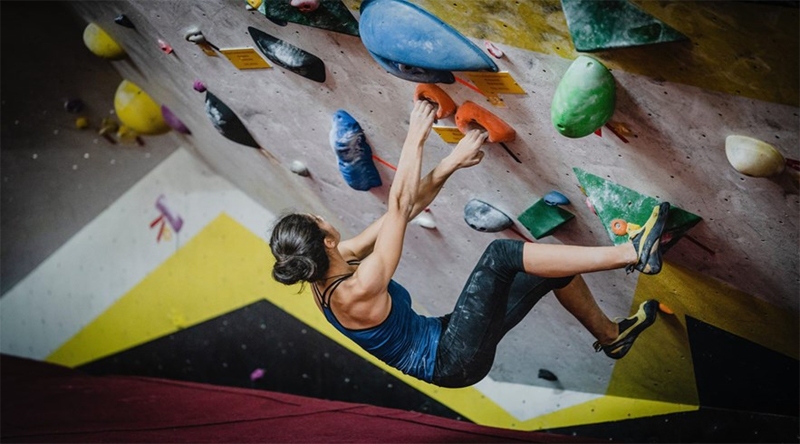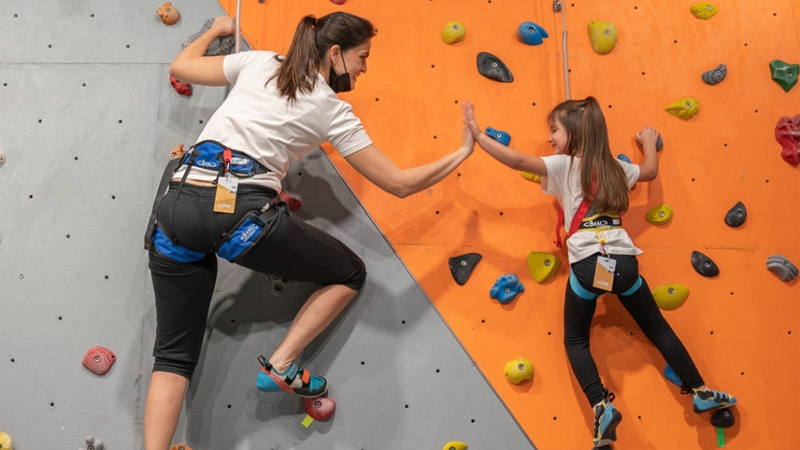A Basic Guide to Indoor Wall Climbing for Beginners in UAE
In Yas Island Abu Dhabi, there is a building that looks like an asymmetrical Rubik’s Cube. It’s the CLYMB Abu Dhabi adventure hub, which has The SUMMYT, the region’s tallest indoor climbing wall.
You should visit CLYMB if you are in Abu Dhabi. Even beginners can give indoor wall climbing a try. In fact, this is an activity you can enjoy with your family, even a family with young children. Children as young as four can try the sport at CLYMB.
Below is a guide to indoor wall climbing that can help beginners have a safe and enjoyable indoor climbing adventure with their families.
Also Read: 10 Most Popular Adventure Sports In Dubai
Indoor Wall Climbing Types
The following are different types of indoor wall climbing, arranged according to skill level. You can learn or experience all these at the most serious climbing gyms like CLYMB Abu Dhabi.
1. Bouldering
Bouldering refers to climbing shorter walls (i.e., 10 to 15 feet tall) without ropes and harnesses. You only need a good pair of shoes and chalk to start this activity. Of course, the gym is likely to require you to wear a helmet, and the area beneath the boulder should be amply padded to protect novice climbers from fall injuries.
The fact that bouldering requires climbers to climb only short walls and needs minimal equipment makes it a suitable and convenient entry point to the sport for inexperienced climbers.
2. Top-Rope Climbing
In top-rope climbing, also known as top-roping, the rope hangs from an anchor affixed to the top of the climbing wall. The climber is harnessed to one end of the rope, while a belayer holds the other end of the rope so he can slow down the climber’s descent in case of a fall.
Instead of a belayer, a gym may use an auto-belaying device. An auto-belay system automatically takes up the slack as a climber ascends, which prevents a fast, free fall if the climber loses his footing.
Top roping is the default for intermediate and advanced climbers, but beginners can also try top-rope climbing. It’s safe because the climber is always securely tethered to the wall, and a belayer or an auto-belay device is ready to stop a fall.
3. Lead Climbing
In lead climbing, the rope does not pass through an anchor system at the top of the wall. Instead, the cord runs directly from the climber to the belayer or auto-belay system. On the walls are bolts that the lead climber will use to secure himself as he climbs up the wall.
In lead climbing, the climber climbs up a route of his choosing. As he climbs up the wall, he looks for bolts to secure himself. Whenever he finds a bolt along his course, he clips his rope onto it.
Lead indoor wall climbing is only for advanced climbers, so this is not something you will ever be allowed to try as a novice.
Also Read: 18 Craziest Things to do in Dubai
Tips for Safe Indoor Wall Climbing
Follow these tips to ensure your safety when wall climbing.
1. Wear Appropriate Shoes
Your regular trainers should be okay for basic bouldering. However, if you’re serious about learning indoor climbing, you should invest in a good pair of climbing shoes.
Climbing shoes feel snug around the feet, ensuring sensitivity. They will make it easier for your feet to access small gaps.
2. Master the Equipment and the Language
This isn’t much of a concern for beginner climbers dabbling in bouldering. However, in top-rope and lead climbing, mastering how to use your equipment is essential to your safety.
First, you must learn the figure-eight knot so you can attach the rope to the tie-in points of your harness. Next, you need to know how to do equipment checks. You should also confirm that the belayer is ready and his equipment correctly set up.
You must also memorize your climbing commands. To confirm that the belay is on, you will need to ask your belayer, “On belay?” and the belayer will respond with “Belay on.” To signal the start of the climb, you need to verbalize that you are “Climbing,” and the belayer will acknowledge by saying, “Climb on.”
Ideally, you should warn the belayer before falling (especially when practicing falls) by shouting “Falling.” This will alert the belayer so he can be ready to stop your fall.
3. Get Adequate Training
Watching YouTube videos will help you get a head start at indoor climbing. You can also visit one of the public libraries in Abu Dhabi; there should be plenty of reference materials on indoor climbing you can read.
However, the best way to learn indoor climbing is through face-to-face, hands-on training.
Indoor climbing gyms usually have beginner group or one-on-one climbing courses. Make sure to take up these courses to learn all the techniques.
4. Progress Slowly
Practice is necessary to master climbing. You should go on straightforward routes and less challenging climbs when you’re just beginning. The goal at this stage is to become proficient in the climbing techniques, especially those related to your safety, without putting yourself in actual danger.
Once practicing climbing techniques becomes second nature to you, you can slowly progress to more challenging courses, making sure every time to master a level before moving to something more challenging.
5. Practice Falling
Falling is part of climbing, and mastering it is one way you can safeguard your safety. Therefore, a part of your training must be devoted to practicing how to fall safely.
This includes practicing how to tell your belayer that you are falling. It also involves learning how to position your body relative to the rope so you can keep it from being entangled.
6. Listen to Experts
Since you are a novice, listen to climbing experts. They have a valid reason when they ask you to follow specific guidelines. If you’re up the wall and the trainer on the ground asks you to do something, obey first and ask questions later.
Also Checkout:
- Hatta Tour Dubai: All You Need to know about Hatta Oman Tour
- 26 Best Dubai Tourist Attractions You Should Must Visit
Indoor Wall Climbing for Beginners
Indoor wall climbing is a fun and challenging activity that everyone in the family can take part in and enjoy. However, beginners are urged to start with bouldering and only later on progress to the more advanced top roping and lead climbing. However, no matter your proficiency level, you must always use proper equipment and religiously observe safety precautions.






